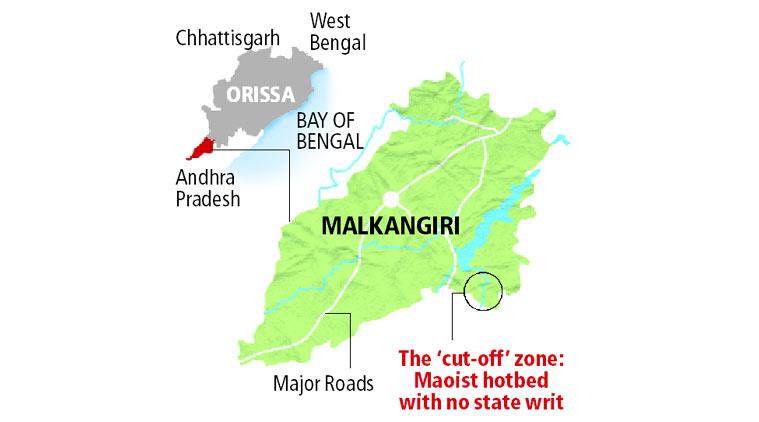April 4, 2015
ORISSA, INDIA – Malkangiri SP Mitrabhanu Mohapatra has 291 personnel for 5,791 sq km area — or one policeman for 20 sq km of difficult, thickly forested terrain. With his men — and a lot of help from central forces — the young IPS officer is trying to choke the jungle corridor known as the Andhra Pradesh-Orissa Border Axis, or AOB axis, which is used by Naxals to move between Orissa and neighboring Chhattisgarh.
April 4, 2015
ORISSA, INDIA – Malkangiri SP Mitrabhanu Mohapatra has 291 personnel for 5,791 sq km area — or one policeman for 20 sq km of difficult, thickly forested terrain. With his men — and a lot of help from central forces — the young IPS officer is trying to choke the jungle corridor known as the Andhra Pradesh-Orissa Border Axis, or AOB axis, which is used by Naxals to move between Orissa and neighboring Chhattisgarh.

“Malkangiri is like a funnel. If this is controlled, Maoism will be over in Orissa,” says Malkangiri SP Mitrabhanu Mohapatra.
Malkangiri is one of the most critical districts affected by Left Wing Extremism (LWE) in India. It also holds the key to fighting the Maoists in Orissa. As Mohapatra puts it, “Malkangiri is like a funnel. If this is controlled, Maoism will be over in Orissa.”
The success of Mohapatra’s project, however, relies heavily on the implementation of a plan that has been around for nearly six decades now. It is a 910-metre bridge on the Gurupriyo river that has been on paper since 1956 and which, if built, would connect at least 22 villages to the rest of India.
This cluster of villages is known to the local administration as the “cut off” area. The Indian state is absent here. It has never been administered since independence. The nearest police station is in Andhra Pradesh, 80 km away.
The area is a Maoist base, and a fertile recruitment ground for their cadres. It is in this area in 2011 — the year that Mohapatra joined the IPS — that IAS officer R Vineel Krishna, then collector of Malkangiri, was abducted by Maoists and held hostage for a week.
It is through the AOB axis that the Maoist group responsible for the 2013 attack on a Congress convoy in Darbha valley in Chhattisgarh had crossed over to Orissa. Almost the entire Congress leadership of Chhattisgarh was wiped out in the attack.
“The six gram panchayats in the cut off area have a population of 25,000-30,000. Maoists are recruiting regularly from these villages. There is a development vacuum there. For such a huge area, we have only two primary health centres, that too at the fringes,” Mohapatra said.
Soil testing for the bridge began only last month, the officer said. “No contractor is ready to take the work. For lack of connectivity, sometimes women in labour have to walk for 30 km for basic healthcare.”
On Orissa’s request, nearly 4,000 Border Security Force (BSF) personnel were sanctioned for the district. Last year, the BSF set up camp near Badapada gram panchayat in the cut-off area.
“It would be impossible for us to operate without the BSF,” Mohapatra said.
Brijesh Kumar Rai, who is in charge of Kalahandi, said his district has begun to emerge as a new operating ground for Maoists. “The Maoists have started to make their presence felt in a small pocket on the border with Chhattisgarh, through which they want to open a corridor to the Saranda forest in Jharkhand. Jo jungle mein rahega usko advantage milega; our boys cannot stay there even for 10 days,” Rai said.
Rai began operations against the rebels after borrowing two platoons (about 40 men) from his batchmate in Koraput district. Orissa recently wrote to the Home Ministry seeking two battalions of the BSF for the region.
An intelligence officer with the BSF whose job is to travel extensively through the four LWE-hit districts of Orissa — Malkangiri, Koraput, Nabrangpur, Rayagada — carries around a book that contains details of 504 alleged cadres of the CPI (Maoist).
“You never know when you may get a small piece information about Maoist cadres leading to their arrest,” he said.
The officer, who is about 35 years old and poses sometimes as a trekker and at other times as a biking enthusiast, said the aim of his intelligence-gathering is to put as many Maoists as possible behind bars.
“Most of the cadres in Orissa are either of Telugu origin or from Chhattisgarh. The tribals here have never seen the government. An aggressive government campaign to counter Maoist propaganda is needed,” he said.
In the four districts where the BSF is deployed, 838 alleged Maoists have been arrested since 2010; another 112 have surrendered. Home Ministry data show the number of Maoist-related incidents in Orissa has dropped from 266 in 2009 to 103 in 2014.
BSF IG H S Sandhu said, “Initially the BSF was deployed on the AOB road axis, now the state government plans to deploy us in the remote areas. Most surrendered Maoists have told us that they didn’t know of the government’s surrender policy.”
Lakshmipur SDPO Hemant Kumar Padhi, who served in Malkangiri for 10 years, said two police stations were constructed with great difficulty in the cut off area around five years ago. “From 2006-13, the 22-km stretch from Lakshmipur to Narayanpatna witnessed a murder or an IED blast almost every one kilometre. Not anymore. Besides combat operations, development works and civic action programmes have made a difference,” he said.
Koraput district, where Lakshmipur is, has been a success story for the police and security forces in the last two years. PR Chhotary, Inspector, Narayanpatna (Koraput), said the return of normalcy was reflected in the changing nature of crime in his police station area.
“In 2005, when Maoist activities were at their peak, 108 cases were registered at the police station, all of which were related to the Explosive Substances Act, or being a member of a banned organization. In 2015, by contrast, not only have we seen only 17 cases registered so far, they are all related to either dowry harassment or petty fights. In 2014, the number of cases was 51,” Chhotary said.
Courtesy: Indian Express

















































































































